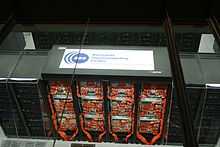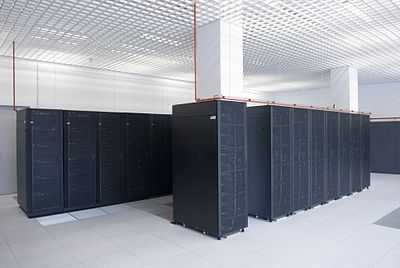Spanish Supercomputing Network

The Spanish Supercomputing Network (RES, Red Española de Supercomputación) is a scientific network created by the Spanish Education Ministry. The network is composed by several supercomputers distributed over Spain. This institution tries to provide the computing resources needed by researchers in Spain and Europe.
Nowadays, the network comprises eight supercomputers:
- Altamira in IFCA, (University of Cantabria, Cantabria).
- CesarAugusta in University of Zaragoza, (Zaragoza).
- LaPalma in IAC, (Canarias).
- Magerit in CeSViMa, (Technical University of Madrid, Madrid).
- MareNostrum in BSC, (Polytechnic University of Catalonia, Barcelona).
- Picasso in University of Malaga, (Malaga).
- Tirant in University of Valencia, (Valencia).
- Atlante in ITC, (Canarias)
All these systems follow the same design, only with different numbers of IBM JS20 or JS21 blades.
History
Spanish Supercomputing Network was created in March 2007 to increase the needs of computing resources in Spain. To achieve this, Magerit and MareNostrum supercomputers were upgraded and the old nodes from MareNostrum were used to create five nodes (Altamira, CesarAugusta, LaPalma, Picasso, Tirant) of the network.
In 2009 Atlante supercomputer joined the network. The software of the supercomputers was upgraded to the same level.
In 2011 Magerit was upgraded and became the most powerful supercomputer in Spain and of this network.
Use of the resources
An Access Committee (a group of 44 researchers who assess the importance of each project) controls the access to the computing resources:
- Every researcher who wants to use the network must send a project to the Access Committee
- All projects are evaluated by the access committee.
- The best projects are accepted. The committee assigns several resources of one of the supercomputers for a 4-month period.
If one project needs more computing resources, the leader of the project can ask for resources in the next 4-month period.
Each institution controls 20% of the resources of its node. CeSViMa controls about 40% of the computer resources of Magerit due to the nodes owned by the Technical University of Madrid. With the upgraded of Magerit in 2011 CeSViMa increased its contribution to the network 5 times, despite only 20% of the computer being scheduled by the network.
Sources
- RES in Barcelona Supercomputing Center website, current coordinator of Spanish Supercomputing Network.
